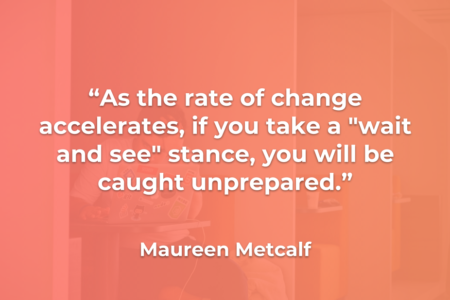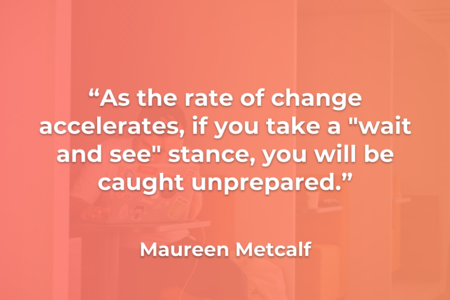
With 2018 coming to a close, many of us are looking to 2019 and beyond. This article was originally published on Forbes.com in August 2018 summarizing the trends that emerged from the last 100 interviews conducted on Voice America Radio, Innovative Leaders Driving Thriving Organizations interview series. It is the companion to an interview between Christopher Washington, PhD and Maureen Metcalf Top Leadership Trends in 2018 and beyond.
I host a weekly radio show that helps leaders update how they lead. The interviews are with key business leaders, global leaders, thought leaders, authors and academics. Each year, I publish the main themes we discuss on the show as well as in my consulting work with senior executives around the world.
I have now completed more than 150 interviews, and volatility was a recurring theme. This article is a synthesis of what we can take away as key factors for leaders and executives to focus on for the next four years.
1. Leaders must pay attention to trends and predictions.
As the rate of change accelerates, if you take a “wait and see” stance, you will be caught unprepared. The intersection of volatility, changes in technology and global interconnection means there are threats and opportunities on all fronts and a large pool of organizations poised to leverage both. Speed continues to matter.
2. Leaders and their organizations are becoming agiler.
A McKinsey survey of more than 2,500 organizations of different sizes, specialties and regions reported that “37 percent of respondents said their organizations are carrying out company-wide agile transformations, and another 4 percent said their companies have fully implemented such transformations. The shift is driven by proof that small, multidisciplinary teams of agile organizations can respond swiftly and promptly to rapidly changing market opportunities and customer demands.”
As leaders, it’s important to adopt a nimble mindset and culture. Being nimble means paying attention to trends and identifying small “experiments” you can run to keep up with or even ahead of the changes happening around you. Once you are clear about what will work for you and how it will work, pilot that change. Truly agile companies are always experimenting.
3. Organizations and their people must accelerate their pace of learning.
With an increase in agility, people and organizations will need to accelerate learning. In 1978, Harvard Business School Professor Emeritus Chris Argyris wrote Organizational Learning: A Theory of Action Perspective. This work continues to evolve and increase in importance, as learning provides a competitive advantage.
Take, for example, how organizations are automating more work. Employees who continue to learn and update their skills will be able to find new roles, while others who are not continually learning will be left unemployed or underemployed as their roles diminish.
4. Age range in the workforce will continue to expand.
As life expectancy continues to increase, many people will want to and need to work longer. Organizations will need to find ways to attract and engage older workers. They will also need to address the dynamics created when multiple generations of employees are working together on the same team.
With the decrease of age-based seniority, leadership will be taken by the best person for the role and will likely shift frequently in an agile environment. Organizations need to be creative in promoting engagement and teamwork across multiple generations.
5. Leaders need to identify and build talent at an increasing rate.
As technology evolves and organizations change more quickly, employees need to learn faster, and organizations need to identify workers to fill changing talent needs. Some of these needs will fall in the technology space, but not all.
We referenced older employees remaining in the workforce and returning. We also need to find ways to engage talent who have been previously overlooked. This could mean people leaving incarceration, people with disabilities who would, in fact, be great fits for certain roles, or adults who work from home because they are caregivers to their children or parents, to name a few.
6. Employee engagement will continue to be important in volatile times.
The importance of human interaction will continue to increase even as more of the workforce is working remotely – many rarely, if ever, meeting their colleagues. Leaders and organizations need to focus on soft skills such as emotional intelligence that have a strong impact on engagement and the effort employees put into communicating.
7. Communities must come together to solve quality-of-life and economic issues.
With the level of change, segments of the economy can easily be excluded from the workforce. The gap between economic haves (those with education, access and resources) and have-nots can increase, and the cost can be significant for the individuals, families and businesses impacted by a worker shortage.
Successful regions create organizations to tackle these challenges. This means organizations that traditionally compete for resources and clients also need to work together to solve challenges that impact them.
8. Effective leaders are conscious of their impact across a broad range of factors and stakeholders.
As we talk about conscious capitalism, the main idea is that “conscious” organizations tend to the health of a broad range of stakeholders. It becomes increasingly important to pay attention to the needs of competing stakeholders and balance these demands. Conscious capitalism is one mechanism that helps leaders explore the broader range of stakeholders and understand their drivers.
Business is getting more complicated and requires leaders to continually update their skills as well as their mindset and focus. This article summarizes some of my key learnings.
As a leader, are you seeing similar trends? What’s missing? What are you doing to prepare yourself and your organization to succeed during the next four years?
As a reader of this blog and listener to the interviews, please consider enrolling in one of the innovative leadership online leader development program. For additional tools, we recommend taking leadership assessments, using the Innovative Leadership Fieldbook and Innovative Leaders Guide to Transforming Organizations, and adding coaching through our online innovative leadership program. We also offer several workshops to help you build these skills.
Maureen Metcalf, CEO of Metcalf & Associates is a renowned executive advisor, author, speaker, coach and consultant.





